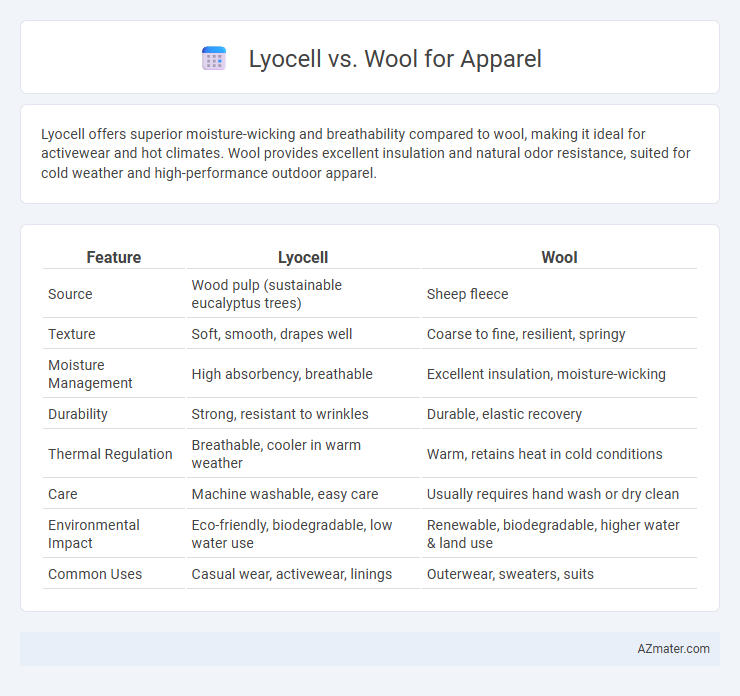Lyocell offers superior moisture-wicking and breathability compared to wool, making it ideal for activewear and hot climates. Wool provides excellent insulation and natural odor resistance, suited for cold weather and high-performance outdoor apparel.
Table of Comparison
| Feature | Lyocell | Wool |
|---|---|---|
| Source | Wood pulp (sustainable eucalyptus trees) | Sheep fleece |
| Texture | Soft, smooth, drapes well | Coarse to fine, resilient, springy |
| Moisture Management | High absorbency, breathable | Excellent insulation, moisture-wicking |
| Durability | Strong, resistant to wrinkles | Durable, elastic recovery |
| Thermal Regulation | Breathable, cooler in warm weather | Warm, retains heat in cold conditions |
| Care | Machine washable, easy care | Usually requires hand wash or dry clean |
| Environmental Impact | Eco-friendly, biodegradable, low water use | Renewable, biodegradable, higher water & land use |
| Common Uses | Casual wear, activewear, linings | Outerwear, sweaters, suits |
Introduction to Lyocell and Wool Fabrics
Lyocell is a sustainable fabric made from wood pulp, known for its softness, breathability, and moisture-wicking properties, making it ideal for comfortable apparel. Wool, derived from sheep fleece, offers natural insulation, durability, and odor resistance, commonly used in cold-weather clothing. Both fabrics serve distinct purposes in apparel, with Lyocell favored for lightweight, eco-friendly garments and wool preferred for warmth and resilience.
Fiber Origins and Production Processes
Lyocell fibers originate from sustainably harvested eucalyptus trees through a closed-loop solvent spinning process that recycles water and chemicals, minimizing environmental impact. Wool is derived from the fleece of sheep, requiring shearing and traditional cleaning methods that involve substantial water and energy use. The production of lyocell emphasizes eco-friendly practices and biobased raw materials, while wool manufacturing hinges on animal husbandry and natural fiber processing.
Environmental Impact: Lyocell vs Wool
Lyocell, a biodegradable fiber made from sustainably sourced wood pulp, offers a lower environmental footprint compared to wool due to its closed-loop production process that recycles water and solvents, significantly reducing pollution. Wool production involves methane emissions from sheep, land degradation, and higher water usage but is renewable and biodegradable with natural insulation properties. Choosing between lyocell and wool for apparel depends on prioritizing either reduced chemical waste and water use or supporting animal-based, renewable fibers with carbon-sequestering benefits.
Comfort and Wearability Comparison
Lyocell fabric offers superior moisture-wicking and breathability compared to wool, making it ideal for warm and humid conditions with soft, smooth texture that reduces skin irritation. Wool excels in thermal insulation and natural odor resistance, providing warmth and comfort in colder climates while maintaining durability and stretch. Both materials deliver distinct wearability benefits, with Lyocell suited for lightweight, breathable apparel and wool for effective temperature regulation in cooler environments.
Moisture Management and Breathability
Lyocell fibers excel in moisture management by wicking sweat away from the skin and promoting rapid evaporation, ensuring a dry and comfortable experience during physical activity. Wool naturally regulates moisture through its hygroscopic properties, absorbing significant amounts of moisture vapor without feeling wet, which maintains warmth and breathability even in damp conditions. Both materials offer superior breathability; however, Lyocell often provides a lighter, cooler feel, while wool delivers insulation with consistent air circulation.
Durability and Care Requirements
Lyocell offers high durability with excellent resistance to wear and tear, making it a practical choice for everyday apparel; its moisture-wicking properties also contribute to fabric longevity. Wool excels in durability due to its natural elasticity and resilience, maintaining shape and insulation over time even with frequent use. Care requirements for Lyocell are relatively simple, usually involving gentle machine washing and air drying to prevent shrinkage, while wool demands more delicate care, including hand washing or dry cleaning to avoid felting and damage.
Skin Sensitivity and Hypoallergenic Properties
Lyocell fabric, derived from sustainably sourced wood pulp, offers superior moisture-wicking and breathability, reducing irritation for sensitive skin and making it an excellent hypoallergenic choice in apparel. Wool, particularly merino wool, provides natural temperature regulation and antimicrobial properties but may cause itching or allergic reactions in individuals with wool sensitivity. Choosing Lyocell over wool benefits those prone to skin irritation by minimizing allergens and ensuring gentle, comfortable wear.
Style and Aesthetic Differences
Lyocell fabric offers a sleek, smooth finish with a subtle sheen, making it ideal for modern, minimalist apparel designs that emphasize clean lines and fluid draping. Wool provides rich texture and volume, contributing to a more traditional, cozy aesthetic often favored in tailored suits, sweaters, and outerwear. The natural luster of lyocell contrasts with wool's matte and sometimes fuzzy surface, creating distinct visual appeals suited for different style preferences.
Cost and Market Availability
Lyocell offers a cost-effective alternative to wool, with generally lower production expenses due to its renewable wood pulp source, making it more accessible in budget-friendly apparel markets. Wool, known for its durability and warmth, commands higher prices and is primarily available through specialized retailers and premium brands. Market availability of lyocell has expanded rapidly thanks to sustainable fashion trends, while wool remains strong in traditional and luxury segments with seasonal fluctuations impacting supply.
Conclusion: Choosing the Best Fabric for Apparel
Lyocell offers superior moisture-wicking, breathability, and sustainability advantages ideal for active or warm-weather apparel, while wool excels in natural insulation, durability, and odor resistance, making it perfect for cold climates and outdoor wear. The best fabric choice depends on specific clothing needs: Lyocell suits lightweight, eco-friendly garments, whereas wool provides warmth and resilience in harsher conditions. Evaluating factors like climate, comfort preferences, and environmental impact ensures optimal fabric selection for apparel.

Infographic: Lyocell vs Wool for Apparel
 azmater.com
azmater.com